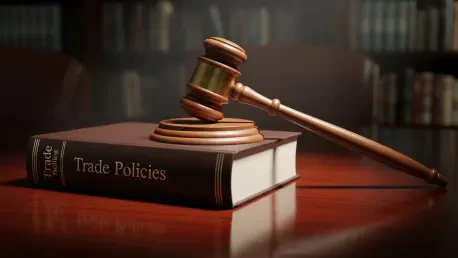The global trade arena stands at a critical juncture, with tensions simmering over new regulations that could reshape economic alliances and energy security across continents. Imagine a scenario where a single policy shift in Europe threatens to disrupt billions in trade deals, halt vital energy supplies, and strain long-standing partnerships with major powers like the United States. This is the reality facing the international community as the European Union pushes forward with ambitious sustainability directives, prompting stark warnings from across the Atlantic. With the stakes higher than ever, this report delves into the intricate web of trade dynamics, examining how these new rules could redefine geopolitical and economic landscapes for years to come.
The Global Trade Landscape: A Complex Web of Interests
International trade today operates as a vital engine of global prosperity, weaving together economies through a delicate balance of geopolitical strategy and economic necessity. It underpins not just financial growth but also political stability, with trillions of dollars in goods and services exchanged annually among nations. The interplay of tariffs, alliances, and regulatory frameworks often dictates the strength of diplomatic ties, making trade a linchpin of modern international relations.
Key players such as the United States, the European Union, the United Kingdom, China, and emerging economies each hold significant sway in this intricate system. The US and EU dominate as economic powerhouses with intertwined markets, while China’s manufacturing prowess shapes global supply chains. The UK, navigating its post-Brexit identity, seeks to redefine partnerships, and rising economies in Asia and Africa add new dimensions to competition and collaboration, creating a network of dependencies that can shift with a single policy change.
Central to current discussions are pressing issues like environmental regulations, which aim to curb carbon footprints but often clash with economic priorities. Tariff policies remain a tool for protecting domestic industries, yet they risk igniting retaliatory measures. Additionally, shifting trade partnerships, driven by geopolitical tensions or economic recalibrations, continue to reshape the global order, setting the stage for debates over sustainability versus stability in an interconnected world.
Rising Tensions Over EU’s New Regulations
The Corporate Sustainability Due Diligence Directive (CSDDD)
At the heart of recent trade disputes lies the EU’s proposed Corporate Sustainability Due Diligence Directive, a groundbreaking policy designed to hold companies accountable for environmental and human rights impacts within their supply chains. Targeting firms with significant turnover in the EU, the directive imposes strict penalties for non-compliance, aiming to foster a more ethical global market. Its ambition is clear: to lead the charge in sustainable practices on an international scale.
However, this bold move has sparked alarm among key trade partners, notably the United States and Qatar, who have jointly labeled it an existential threat to Europe’s economic health and energy security. Their concerns, articulated in a pointed statement, highlight fears that the directive could severely disrupt trade flows and investment streams. The potential for strained relations looms large, as these nations question whether the EU has underestimated the broader implications of such stringent rules.
A particular point of contention is the impact on energy supplies, especially US liquefied natural gas exports to the EU, which are critical for the region’s energy needs. Disruptions in this sector could ripple through markets, affecting prices and availability, while also threatening long-term agreements. The clash between sustainability goals and practical economic dependencies underscores a growing divide in how global partners view the path forward.
Implications for US-EU Trade Agreements
The friction over the CSDDD extends to recently forged trade agreements between the US and EU, casting doubt on their durability. A landmark tariff deal, which includes a commitment to $750 billion in US energy purchases by 2029, now faces uncertainty as the new regulations threaten to impose additional costs and compliance burdens on American firms. This development risks unraveling years of diplomatic and economic negotiations.
Market reactions have been swift, with analysts noting fluctuations in energy sector investments as stakeholders weigh the potential fallout. Experts caution that while the EU’s sustainability push is commendable, it must be balanced against the realities of economic interdependence. Some argue that without careful calibration, the directive could erode trust between transatlantic partners, potentially leading to retaliatory trade measures.
The broader discourse among industry leaders reveals a split in perspectives. While some advocate for a phased approach to implementation, others warn that any delay in addressing environmental concerns could undermine global efforts. Navigating this delicate balance will be crucial for maintaining the integrity of US-EU economic ties amid mounting regulatory pressures.
Challenges in Balancing Trade and Policy Goals
Integrating environmental and human rights priorities into trade frameworks presents a formidable challenge for policymakers worldwide. The EU’s aggressive stance on sustainability, while setting a moral benchmark, often collides with the immediate needs of economic stability and growth. This tension highlights a fundamental question: how can ethical imperatives coexist with the practicalities of global commerce without causing widespread disruption?
Criticism of the EU’s net zero 2050 goal has been particularly sharp, with figures like US Energy Secretary Chris Wright decrying it as a human impoverishment program. Such critiques reflect a broader unease among some trade partners that overly ambitious environmental targets could lead to reduced industrial output and higher costs for consumers. The fear is that these policies might prioritize ideology over economic viability, straining livelihoods in the process.
To mitigate potential fallout, strategies such as phased regulatory rollouts and enhanced dialogue between nations are gaining traction. Economic repercussions, including supply chain delays and increased operational costs, could be softened through collaborative frameworks that allow for adaptation. Striking this balance requires a nuanced approach, ensuring that ethical standards advance without triggering trade wars or market instability.
Shifting Trade Policies and Protectionist Trends
Beyond the EU’s regulatory shifts, other nations are reevaluating their trade policies to address perceived imbalances, signaling a rise in protectionist measures. The UK, for instance, is considering scrapping the de minimis import duty exemption for small packages valued under £135, a policy that currently benefits exporters like China, which dominates over half of such shipments. This potential change aims to protect domestic businesses by leveling the competitive field.
Similar actions in the US, under both recent and current administrations, reflect a parallel trend to curb advantages for foreign exporters. Policies targeting Chinese goods through tariffs and exemptions have intensified, driven by a desire to bolster local industries. These moves, while popular domestically, risk escalating tensions with major trading partners, potentially sparking broader retaliatory actions in the global market.
The impact on domestic industries could be significant, offering short-term relief to local producers but also raising concerns about higher consumer prices and supply chain bottlenecks. As Western nations tighten their trade rules, the ripple effects on international exporters underscore the fragility of current economic relationships. The challenge lies in implementing these policies without igniting a cycle of tit-for-tat measures that could destabilize global trade further.
Future Directions in Global Trade Dynamics
Looking ahead, the trajectory of global trade appears fraught with regulatory tensions and evolving partnerships that could redefine economic hierarchies. The push for sustainability, coupled with protectionist policies, is likely to intensify debates over how nations collaborate or compete in an increasingly fragmented landscape. Navigating these shifts will demand agility and foresight from policymakers and industry leaders alike.
Emerging trends, such as Germany’s renewed focus on trade with China due to declining exports to the US amid tariff pressures, illustrate the fluidity of alliances. Bilateral trade between Germany and China has surged, surpassing volumes with traditional partners, signaling a pragmatic pivot driven by economic necessity. This realignment highlights how tariff policies in one region can reshape trade flows elsewhere, often in unexpected ways.
Potential disruptors, including new trade deals like those between the US and India, add further complexity to the equation. Geopolitical frictions, from energy disputes to territorial concerns, continue to influence trade routes and agreements, creating uncertainty. As these dynamics unfold, the global trade environment stands poised for transformation, with outcomes hinging on the ability to adapt to both policy and political currents.
Conclusion: Navigating a Fragmented Trade Environment
Reflecting on the tensions that unfolded between the US, EU, and other global players, it became evident that new trade rules and policies had strained long-standing economic bonds. The EU’s pursuit of sustainability through directives like the CSDDD, while rooted in ethical intent, had ignited fierce debates over economic stability, drawing sharp rebukes from key allies. Parallel shifts, such as the UK’s reconsideration of import exemptions and Germany’s trade pivot toward China, had further underscored the fragmented nature of global commerce.
Moving forward, actionable steps emerged as critical for mitigating these challenges. Policymakers needed to prioritize open dialogue, fostering platforms where nations could negotiate balanced frameworks that addressed both sustainability and trade security. Collaborative mechanisms, such as joint task forces on regulatory impacts, offered a pathway to align diverse priorities. By investing in adaptive strategies and transparent communication, the international community could work toward a trade environment that supported ethical goals without sacrificing economic resilience.









